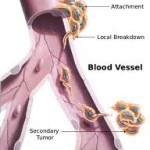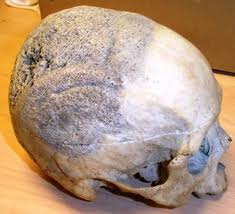A tumor is a collection of abnormal cells grouped together. However, not all tumors are cancerous. A tumor can be benign (not cancerous) or malignant (cancerous). Benign tumors are usually less dangerous and are not able to spread to other parts of the body. Benign tumors can still be dangerous. They can continue to grow and expand locally. This can lead to compression and damage to the surrounding structures. Malignant tumors are usually more serious and can spread to other areas in the body.
 The ability of cancer cells to leave their initial location and move to another location in the body is called metastasis. Metastasis can occur by the cancer cells entering the body’s bloodstream or lymphatic system to travel to other sites in the body. When cancer cells metastasize to other parts of the body, they are still named by the original type of abnormal cell. For example, if a group of breast cells becomes cancerous and metastasizes to the bones or liver, it is called metastatic breast cancer instead of bone cancer or liver cancer. Many different types of cancer are able to metastasize to the bones. The most common types of cancer that spread to the bones are cancers of the lung, breast, prostate, thyroid, and kidney. Cancers arising from lymphatic or blood cells, including lymphoma and multiple myeloma, can also frequently affect the bones.
The ability of cancer cells to leave their initial location and move to another location in the body is called metastasis. Metastasis can occur by the cancer cells entering the body’s bloodstream or lymphatic system to travel to other sites in the body. When cancer cells metastasize to other parts of the body, they are still named by the original type of abnormal cell. For example, if a group of breast cells becomes cancerous and metastasizes to the bones or liver, it is called metastatic breast cancer instead of bone cancer or liver cancer. Many different types of cancer are able to metastasize to the bones. The most common types of cancer that spread to the bones are cancers of the lung, breast, prostate, thyroid, and kidney. Cancers arising from lymphatic or blood cells, including lymphoma and multiple myeloma, can also frequently affect the bones.
Most of the time, when people have cancer in their bones, it is caused by cancer that has spread from elsewhere in the body to the bones. It is much less common to have a true bone cancer, a cancer that arises from cells that make up the bone. It is important to determine whether the cancer in the bone is from another site or is from a cancer of the bone cells themselves. The treatments for cancers that have metastasized to the bone are often based on the initial type of cancer.
What causes bone cancer?
Bone cancer is caused by a problem with the cells that make bone. More than 2,000 people are diagnosed in the United States each year with a bone tumor. Bone tumors occur most commonly in children and adolescents and are less common in older adults. Cancer involving the bone in older adults is most commonly the result of metastatic spread from another tumor.
There are many different types of bone cancer. The most common primary bone tumors include osteosarcoma, Ewing’s sarcoma, chondrosarcoma, malignant fibrous histiocytoma, fibrosarcoma, and chordoma.
- Osteosarcoma is the most common primary malignant bone cancer. It most commonly affects males between 10 and 25 years old but can less commonly affect older adults. It often occurs in the long bones of the arms and legs at areas of rapid growth around the knees and shoulders of children. This type of cancer is often very aggressive with risk of spread to the lungs. The five-year survival rate is about 65%.
- Ewing’s sarcoma is the most aggressive bone tumor and affects younger people between 4-15 years of age. It is more common in males and is very rare in people over 30 years of age. It most commonly occurs in the middle of the long bones of the arms and legs. The three-year survival rate is about 65%, but this rate is much lower if there has been spread to the lungs or other tissues of the body.
- Chondrosarcoma is the second most common bone tumor and accounts for about 25% of all malignant bone tumors. These tumors arise from the cartilage cells and can either be very aggressive or relatively slow growing. Unlike many other bone tumors, chondrosarcoma is most common in people over 40 years of age. It is slightly more common in males and can potentially spread to the lungs and lymph nodes. Chondrosarcoma most commonly affects the bones of the pelvis and hips. The five-year survival for the aggressive form is about 30%, but the survival rate for slow-growing tumors is 90%.
-
Malignant fibrous histiocytoma (MFH) affects the soft tissues, including muscle, ligaments, tendons, and fat. It is the most common soft-tissue malignancy in later adult life, usually occurring in people 50-60 years of age. It most commonly affects the extremities and is about twice as common in males as females. MFH also has a wide range of severity. The overall five-year survival rate is about 35%-60%.
- Fibrosarcoma is much rarer than the other bone tumors. It is most common in people 35-55 years of age. It most commonly affects the soft tissues of the leg behind the knee. It is slightly more common in males than females.
- Chordoma is a very rare tumor with an average survival of about six years after diagnosis. It occurs in adults over 30 years of age and is about twice as common in males as females. It most commonly affects either the lower or upper end of the spinal column.


